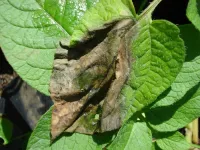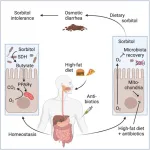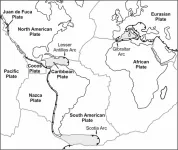(Press-News.org) The first accurate maps of outbreaks of potato blight — a disease caused by the fungus-like pathogen Phytophthora infestans that was responsible for the Irish potato famine between 1845 and 1852 — in the USA between 1843 and 1845 are presented in a study published in Scientific Reports. The findings improve our understanding of the spread of potato blight before the disease reached Europe.
Jean Ristaino and colleagues mapped outbreaks of potato blight in North America between 1843 and 1845 by analysing historic agricultural reports published in the USA during this period. The authors found that the disease was first reported in 1843 in five locations in the states of New York, Pennsylvania, New Jersey, Delaware, and Connecticut. By the end of 1844 the disease had spread to 107 additional locations, a further six US states (Ohio, Massachusetts, Rhode Island, Vermont, New Hampshire, and Maine) and the Canadian province of Nova Scotia. In 1845 the disease spread to 53 new locations, including in four additional US states (Michigan, Illinois, Indiana, Maryland) and the Canadian province of New Brunswick. Contemporary reports suggested that the disease led to crop losses of between 33 and 50%.
The authors also used their approach to characterise historical theories on the source of potato blight and remedies for treating the disease between 1843 and 1845. Proposed causes of the disease during this period included insects, weather conditions, poor quality potato varieties, and a fungus. In addition, the authors identified a widely described debate in reports about whether the fungus was the cause or a consequence of the disease. Suggested treatments for the disease included calcium oxide (known as lime), sulfur, copper sulfate (known as bluestone copper), and salt. Infected imported potato seed tubers from locations including Nova Scotia, France, and Bogota, Colombia were suspected as sources of the disease.
Together, the findings provide insight into the spread of potato blight in the USA and into public understanding of disease in the mid-19th century.
###
Article details
Reconstructing historic and modern potato late blight outbreaks using text analytics
DOI: 10.1038/s41598-024-52870-2
Corresponding Author:
Jean Ristaino
North Carolina State University, Raleigh, NC, USA
Email: jean_ristaino@ncsu.edu
Please link to the article in online versions of your report (the URL will go live after the embargo ends): https://www.nature.com/articles/s41598-024-52870-2.
END
Plant disease: Mapping the spread of potato blight prior to the Irish potato famine *IMAGES*
2024-02-15
ELSE PRESS RELEASES FROM THIS DATE:
New treatment for a rare and aggressive cancer improves survival rates in breakthrough clinical trial
2024-02-15
An innovative treatment significantly increases the survival of people with malignant mesothelioma, a rare but rapidly fatal type of cancer with few effective treatment options, according to results from a clinical trial led by Queen Mary University of London.
The phase 3 clinical trial, led by Professor Peter Szlosarek at Queen Mary and sponsored by Polaris Pharmaceuticals, has unveiled a breakthrough in the treatment of malignant pleural mesothelioma (MPM), a rare and often rapidly fatal form ...
Weight loss treatment and longitudinal weight change among patients with obesity
2024-02-15
About The Study: In this study of primary-care patients with obesity, all weight management treatments (nutrition counseling, very low-calorie meal replacement, anti-obesity medications, and bariatric surgery) increased the patient-level probability of achieving 5% or greater weight loss, but current rates of utilization are low and insufficient to reduce weight at the population level.
Authors: Dina H. Griauzde, M.D., M.Sc., of the University of Michigan in Ann Arbor, is the corresponding author.
To access the embargoed study: Visit our For The Media website at this link https://media.jamanetwork.com/
(doi:10.1001/jamanetworkopen.2023.56183)
Editor’s ...
Traumatic brain injury and subsequent risk of brain cancer in US veterans of the Iraq and Afghanistan wars
2024-02-15
About The Study: Moderate or severe and penetrating traumatic brain injury (TBI) were associated with the subsequent development of brain cancer in this study of more than 1.9 million veterans of the Iraq and Afghanistan wars. However, mild TBI was not associated with later brain cancer diagnoses.
Authors: Ian J. Stewart, M.D., of the Uniformed Services University of Health Sciences in Bethesda, Maryland, is the corresponding author.
To access the embargoed study: Visit our For The Media website at this link https://media.jamanetwork.com/
(doi:10.1001/jamanetworkopen.2023.54588)
Editor’s ...
Using written records – and tweets – as a roadmap for plant disease spread
2024-02-15
North Carolina State University researchers used text analytics on both historic and modern writing to reveal more information about the effects and spread of the plant pathogen – now known as Phytophthora infestans – that caused the 1840s Irish potato famine and that continues to vex breeders of potatoes and tomatoes.
The study examined keyword terms like “potato rot” and “potato disease” after digitizing historic farm reports, news accounts and U.S. Patent Office agricultural records from 1843 ...
Telehealth is as safe as a visit to the clinic for abortion pills
2024-02-15
Large national study finds that video visits, texting and mailing pills are all effective, as the U.S. Supreme Court considers limiting access to telemedicine abortion.
Medication abortion can be delivered safely and effectively through telemedicine, according to new research from UC San Francisco that comes as the U.S. Supreme Court is about to hear a case that could severely restrict access to one of the two pills that are used to induce abortions.
Researchers analyzed data from more than 6,000 patients who obtained abortion ...
Do sugar-free candy and gum give you gas? Researchers think they know why
2024-02-15
(SACRAMENTO, Calif.) — Researchers at UC Davis have identified changes in the gut microbiome that can result in an inability to digest sorbitol.
Sorbitol, a sugar alcohol, is used in sugar-free gum, mints, candy and other products. It is also found naturally in apricots, apples, pears, avocadoes and other foods. At high levels, sorbitol can cause bloating, cramps and diarrhea. For some people, even a small amount causes digestive upset, a condition known as sorbitol intolerance.
A new study with mice found that taking antibiotics, combined with a high-fat diet, reduced the number of Clostridia gut microbes, which can break down sorbitol. ...
Health and zombie cells in aging
2024-02-15
With age, cells can experience senescence, a state where they stop growing but continue releasing inflammatory and tissue-degrading molecules. When a person is young, the immune system responds and eliminates senescent cells, often referred to as zombie cells. However, zombie cells linger and contribute to various age-related health problems and diseases. Mayo Clinic researchers, in two studies, shed light on the biology of aging cells.
In a study published in Aging Cell, Mayo Clinic researchers analyzed zombie ...
Early-stage subduction invasion
2024-02-15
Contributed by Arianna Soldati, GSA Science Communication Fellow
Our planet’s lithosphere is broken into several tectonic plates. Their configuration is ever-shifting, as supercontinents are assembled and broken up, and oceans form, grow, and then start to close in what is known as the Wilson cycle.
In the Wilson cycle, when a supercontinent like Pangea is broken up, an interior ocean is formed. In the case of Pangea, the interior ocean is the Atlantic. This ocean has a rift in the middle, and passive margins on the side, which means no seismic or volcanic activity occurs along its shores. Destined to keep expanding, an Atlantic-type ...
Targeting the transporter
2024-02-15
When an enemy invades, defenders are ferried to the site to neutralise the marauders. In the human body, a protein carrier called SPNS2 transports S1P molecules from endothelial cells to rally immune cell response in infected organs and tissues.
Using specially-developed nanobodies that bind to SPNS2 and enlarge the entire structure, the enlarged SPNS2 structure allows the S1P molecules to be viewed via cryogenic electron microscopy. Scientists from the Immunology Translational Research Programme at the Yong Loo Lin School of Medicine, ...
AERA announces 2024 Fellows
2024-02-15
WASHINGTON, February 15, 2024—The American Educational Research Association (AERA) has announced the selection of 24 exemplary scholars as 2024 AERA Fellows. The AERA Fellows Program honors scholars for their exceptional contributions to, and excellence in, education research. Nominated by their peers, the 2024 Fellows were selected by the Fellows Committee and approved by the AERA Council, the association’s elected governing body. They will be inducted during a ceremony at the 2024 Annual Meeting in Philadelphia on April 12. With this cohort, there will be a total of 762 AERA ...


